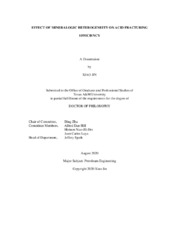| dc.description.abstract | Creating sufficient and sustained fracture conductivity contributes directly to the success of acid fracturing treatments. The permeability and mineralogy distributions of formation rocks play significant roles in creating non-uniformly etched surfaces that can withstand high closure stress. Previous studies showed that depending on the properties of formation rock and acidizing conditions (acid selection, formation temperature, injection rate, and contact time), a wide range of etching patterns (roughness, uniform, channeling) could be created. Different etching patterns can dictate the resultant fracture conductivity. Insoluble minerals and their distribution can completely change the outcomes of acid fracturing treatments. However large portion of acid fracturing studies is based on experimental investigation and uses homogeneous rock samples such as Indiana limestones that do not represent the highly heterogeneous features of carbonate rocks. This work studies the effect of heterogeneity, and more importantly, the distribution of insoluble rock on acid fracture conductivity.
In this research, acid fracturing experiments were conducted using both outcrop homogeneous Indiana limestone samples and heterogeneous downhole carbonate rock samples. The Indiana limestone tests served as a baseline. The highly heterogeneous carbonate rock samples contain several types of insoluble minerals, such as quartz, anhydrite, pyrite, and various kinds of clays, along with sealed natural fractures. These minerals are distributed in the form of streaks correlated against the flow direction, or as smaller nodules. After acidizing the rock samples, these minerals act as pillars that significantly reduce fracture conductivity decline at higher closure stresses. Both x-ray diffraction (XRD) and x-ray fluorescence (XRF) test results help pinpoint the type and location of different minerals on the fracture surfaces. Surface scans showing surface topography after acidizing injection is captured by a surface profilometer. The surface scan results were used to correlate fracture conductivity as a function of mineralogy distribution. Theoretical models considering geostatistical correlation parameters were used to match and understand the experimental results.
The observations of the experimental study showed that insoluble minerals with higher mechanical properties were less crushed at higher closure stresses, resulting in a less steep conductivity decline with increased closure stress. If the acid-etching creates enough conductivity, the rock sample can sustain higher closure stress with a much lower fracture conductivity decline rate compared with Indiana limestone samples. Fracture surfaces with insoluble mineral streaks correlated against the flow direction offer the benefit of being able to maintain conductivity at high closure stress, but not necessarily high initial conductivity.
Using a fracture conductivity model with correlation length, the fracture conductivity behavior for the homogenous rock samples were matched. To match the downhole samples fracture conductivity behavior, the fracture conductivity model was modified with both x-ray diffraction tests for mineralogy distribution and triaxial tests for the rock’s Young’s Modulus. Parametric study with the geostatistical parameters was conducted to show that the fracture surfaces with mineral streaks correlated with the flow direction could increase initial acid fracturing conductivity significantly as compared to the case when the streak is correlated against the flow direction.
The modified fracture conductivity mineralogy model was used in an acid fracturing model to calculate the overall fracture conductivity after the acid etched-width has been determined and the model is validated with the production data from a vertical deep carbonate well. The study used an inverse workflow to match the treatment pressure, determine fracture geometry, and match experimental fracture conductivity results with that simulated by the acid fracturing model.
This study shows that fracture conductivity can be optimized by taking advantage of the distribution of insoluble minerals along the fracture surface, and discusses the critical considerations to make the acid fracturing treatment successful. If the surface minerals are not properly accounted for as pillars, fracture conductivity at higher closure stresses might be severely under-predicted, leading to acid fracturing not being used even though it is a cost-effective simulation method. | en |


